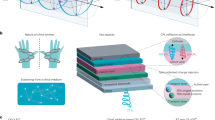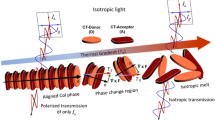Abstract
Combinations of sheet polarizers and colour filters form the basis of numerous products1,2,3,4 — most notably colour liquid-crystal displays2,4 — that require polarized chromatic light. But this combination of elements does not make efficient use of light, as a substantial fraction of the incident light is converted into thermal energy3,4, limiting the brightness and energy efficiency of the resulting devices. Here we show that these limitations can be overcome by using polymer-based photoluminescent polarizers. Our polarizers operate on a two-step principle: randomly orientated ‘sensitizer’ molecules harvest the incident light by isotropic absorption and then efficiently transfer the energy to a uniaxially orientated photoluminescent polymer, from which coloured light with a high degree of linear polarization is emitted. In principle, isotropic-to-polarized conversion efficiencies approaching unity could be attainable by this approach.
This is a preview of subscription content, access via your institution
Access options
Subscribe to this journal
Receive 51 print issues and online access
$199.00 per year
only $3.90 per issue
Buy this article
- Purchase on Springer Link
- Instant access to full article PDF
Prices may be subject to local taxes which are calculated during checkout





Similar content being viewed by others
References
Kliger, D. S., Lewis, J. W. & Randall, C. E. Polarized Light in Optics and Spectroscopy (Academic, San Diego, 1990).
Chan, L. K. M. in The Encyclopedia of Advanced MaterialsVol. 2 (eds Bloor, D., Brook, R. J., Flemings, M. C. & Mahajan, S.) 1294–1304 (Elsevier Science, Oxford, 1994).
Drzaic, P. J. Liquid Crystal Dispersions (World Scientific, Singapore, 1995).
Nelson, T. J. & Wullert, J. R. II Electronic Information Display Technologies (World Scientific, Singapore, 1997).
Schadt, M. & Fünfschilling, J. New liquid crystal polarized color projection principle. Jpn J. Appl. Phys. 29, 1974–1984 (1990).
Broer, D. J., Lub, J. & Mol, G. N. Wide-band reflective polarizers from cholesteric polymer networks with a pitch gradient. Nature 378, 467–469 (1995).
Coates, D.et al. New applications of liquid crystals and liquid crystal polymers. SID 96 Applications Digest SID Int. Symp. Vol. 27, 67–70 (Soc. for Information Display, Santa Ana, 1996).
Wortman, D. L. Arecent advance in reflective polarizer technology. SID 97 Applications Digest SID Int. Symp. Vol. 28(Information Display, Santa Ana, in the press).
Dirix, Y. Polarizers Based on Anisotropic Absorbance or Scattering of Light.Thesis, Tech. Univ. Eindhoven((1997).
Hagler, T. W.et al. Highly ordered conjugated polymers in polyethylene: orientation by mesoepitaxy. Polymer Commun. 32, 339–342 (1991).
Weder, C., Sarwa, C., Bastiaansen, C. & Smith, P. Highly polarized luminescence from oriented conjugated polymer/polyethylene blend films. Adv. Mater. 9, 1035–1039 (1997).
Weder, C., Sarwa, C., Montali, A., Bastiaansen, C. & Smith, P. New photoluminescent display devices. Science 279, 835–837 (1998).
Weder, C., Sarwa, C., Bastiaansen, C. & Smith, P. Photoluminescent display devices.European Patent Application No. 97111229.7((1997).
Tessler, N., Denton, G. J. & Friend, R. Lasing from conjugated-polymer microcavities. Nature 382, 695–697 (1996).
Weder, C. & Wrighton, M. S. Efficient solid-state photoluminescence in new poly(2, 5-dialkoxy-p-phenyleneethynylene)s. Macromolecules 29, 5157–5165 (1996).
Guillet, J. Polymer Photophysics and Photochemistry (Cambridge Univ. Press, New York, 1985).
Webber, S. E. Photon-harvesting polymers. Chem. Rev. 90, 1469–1482 (1990).
Vekshin, N. L. Energy Transfer in Macromolecules (SPIE Optical Engineering Press, Washington, 1997).
Gilbert, A. & Baggot, J. Essentials of Molecular Photochemistry (Blackwell Science, Cambridge, 1997).
Förster, T. Zwischenmolekulare Energiewanderung und Fluoreszenz. Ann. Phys. 2, 55–75 (1948).
Dexter, D. L. Atheory of sensitized luminescence in solids. J. Chem. Phys. 21, 836–850 (1953).
Knox, R. S. Theory of Excitons (Academic, New York, 1963).
Wudl, F. & Srdanov, G. Conducting polymer formed of poly(2-methoxy-5-(2′-ethyl-hexyloxy)-p-phenylenevinylene). US Patent No. 5189136((1993).
Weder, C., Bastiaansen, C., Montali, A. & Smith, P. Efficient photoluminescent polarizers, process for forming and application in devices. European Patent Application No. 98101520.9((1998).
Acknowledgements
We thank Ir. J. Visjager for help in preparing the manuscript.
Author information
Authors and Affiliations
Corresponding author
Rights and permissions
About this article
Cite this article
Montali, A., Bastiaansen, C., Smith, P. et al. Polarizing energy transfer in photoluminescent materials for display applications. Nature 392, 261–264 (1998). https://doi.org/10.1038/32616
Received:
Accepted:
Issue Date:
DOI: https://doi.org/10.1038/32616
This article is cited by
-
Recent advances in chiral AIE polymers
Journal of Nanoparticle Research (2023)
-
Supertransport of excitons in atomically thin organic semiconductors at the 2D quantum limit
Light: Science & Applications (2020)
Comments
By submitting a comment you agree to abide by our Terms and Community Guidelines. If you find something abusive or that does not comply with our terms or guidelines please flag it as inappropriate.



